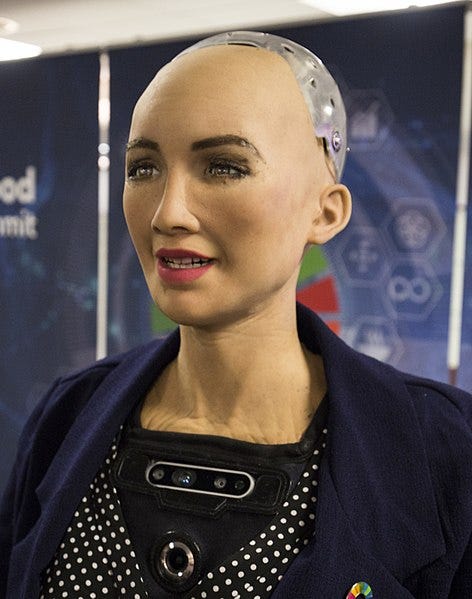The robot Francine
Descartes' mechanical daughter and the impenetrable inner lives of other people
You’ve heard of René Descartes. 17th century French philosopher; cogito ergo sum (I think therefore I am); first principles of enlightenment philosophy and science and all that.
You might be less familiar with Descartes’ robot daughter Francine. The tale of her birth and gruesome death makes for a wild historical(ish) ride in its own right, but it is also finding new relevance in the 21st century. The people who study artificial intelligence and robotics are finding it a helpful tool in thinking through one of the most controversial problems now roiling these academic disciplines: just how humanlike should we make AI and robots?
Anyway let’s back it up before we all get a nosebleed.
In 1635, Francine Descartes was born, the real flesh-and-blood (but illegitimate) daughter of Descartes and a Dutch servant girl. It seems that he loved them both so much that he broke with fairly serious convention to live with them. Just as he was getting ready to bring five-year-old Francine back to France for a proper education, however, the little girl contracted scarlet fever and died. And that’s when things got weird.
The brief existence of Francine Descartes is all properly substantiated. But it’s not where her story ends, if you believe some slightly less rigorously documented – but widely replicated – lore. In addition to coining a foundational principle of Western philosophy, Descartes was also famous for building intricate automata – he loved clockwork dolls and other mechanical creations. And so when Francine died, he was so wracked with grief that he decided to build a mechanical replica, supposedly indistinguishable from the girl as she had been in life.
Details vary from account to account, but most agree that this robot Francine traveled everywhere with him. She “slept” in a kind of casket next to his bed.
In 1646, Christina of Sweden summoned Descartes to her castle and sent a ship for him. The casket went with him on the journey, and at night he would take her out and wind her up and talk to her.
Accounts vary on what happened next, but most converge on the idea that the ship encountered bad weather, and the superstitious crew was getting spooked hearing the chatter in Descartes’ supposedly single room at night. Suspecting some kind of witchcraft – it’s always witchcraft – apparently either the captain or the deck hands broke into the cabin while he slept, opened the casket, and were horrified by what they found inside. (Some accounts insist that she sat up of her own volition, but this taxes even the most credulous mind.)
In any case, the petrified crew grabbed the robot Francine and ran her up to the deck, where they smashed her to pieces which they threw into the sea. (According to one “obscure” account unearthed by Minsoo Kang at the University of Missouri-St. Louis, the captain tossed the automaton overboard because it “worked well enough like a woman with a soul – meaning not very much.”)
Faced with the unbearable grief of losing her a second time – the story goes – Descartes succumbed to death shortly after.
By 1800, this collection of questionable and inconsistent elements had coalesced into the above narrative, and while it was passed around obscure philosophy circles for nearly two centuries, it rarely broke containment. That began to change in the 1990s, when the story started appearing all over the academic map, popping up in disciplines from history, psychology, and literary criticism, to mathematics, robotics, and cybernetics. I first heard the story from Stephen Cave, a director at the Leverhulme Centre for the Future of Intelligence, which studies the implications of AI. Why was it becoming so salient across so many sciences?
“The story is essentially about the ‘disturbing, even revolting notion of a soulless body, a purely physical creature that acts as though it were a person’,” Kang wrote. Philosophers refer to this idea as the “philosophical zombie”. Poke such a creature with a stick, and it would feel no pain, yet could behave exactly as though it did, potentially recoiling, crying out or claiming that you’ve hurt it, while being inwardly unperturbed.
Given the technology available in the 17th century, it is highly unlikely that Robot Francine, if she existed at all, could have been a credible replica of a human.
But Descartes wouldn’t have needed Robot Francine to be convincingly human in order to become an object of his affection. We humans already have a weird tendency to confer agency on the darndest things. We anthropomorphise everything from robots to random commercial goods.
This tendency is massively exploitable. It’s why we now have AI boyfriends and girlfriends, and uncanny fembots who serve as tech world’s ambassadors to totalitarian regimes.
All the while, there hasn’t been much movement on understanding why it’s so hard for people to understand that other people are actually human.
You can see this in its most naked form online, where it is staggeringly easy to dismiss other humans as one-dimensional flatlanders with only the appearance of consciousness, irrelevant except as entertainment. It’s not just easy, it’s the default mode. You have to work really hard to remember or care that all this cacophony is made of people with inner lives just like our own.
This is why I’ve recently started to think of the “hard problem of consciousness” as a critical human software vulnerability. (I used to think it was just a fancy little word problem.) Because when you boil it right down, the “hard problem” of consciousness really amounts to “I know I’m a conscious human with a self but I will need a lot more proof before I believe that you are a conscious human with a self”. Philosophers haven’t even agreed yet on what would constitute proof.
The roots of this problem go deep. They’re foundational. On a recent episode of The Gray Area (a very good podcast), the philosopher Justin Smith-Ruiu traced it back to Descartes. You recall his proof that he exists. Well, he also proved to himself that the material world exists. And that God exists. One important oversight though:
“In the course of establishing the existence of extended stuff, Descartes forgets in his method of radical doubt to prove the existence of other minds! By the end of his famous meditations, all we have established with certainty is the existence of the self and the external world, and God, that’s it.”
Descartes forgot to prove the existence of other people! And that’s the philosophy that suffuses our whole culture, and it’s where we seem to have gotten stuck. Our Robot Francines sleep in our bedrooms while we smash up the humans and throw each other overboard.
Image credits:
The pain pathway. Illustration of the pain pathway as René Descartes conceived of it in Traite de l’homme (Treatise of Man), 1664. Here he theorises a long fiber running from the foot to a cavity in the head. When pulled, it releases a fluid that makes the muscles contract. The pain mechanism was one aspect of Descartes’ notion that the human body functioned like a machine. Public domain.
Descartes with Queen Christina before her drafty castle gave him the cold that is likelier to have killed him than grief over his apocryphal robot child. Public domain.
Sophia: ITU Pictures from Geneva, Switzerland
An older version of this post first appeared at The Last Word on Nothing May 30, 2018






